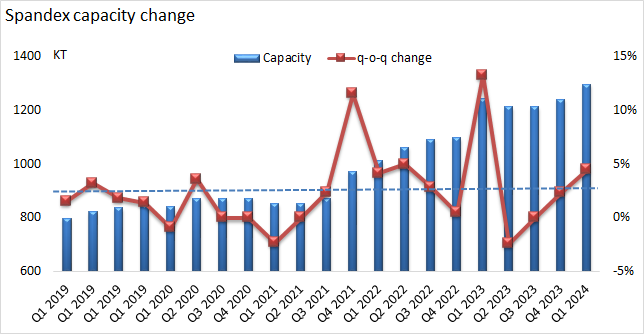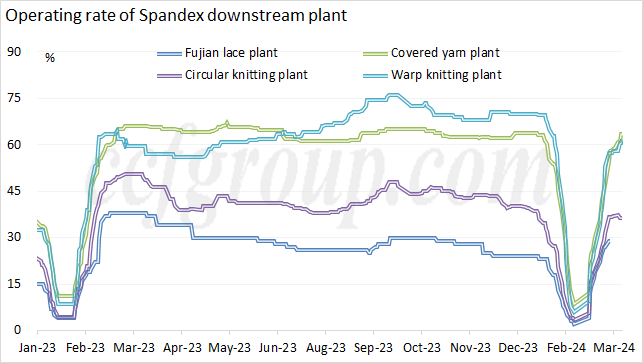Can the spandex market withstand the shortfall in demand expectations?
Since late February, there has been a lackluster performance in domestic and foreign orders for textile and apparels. This year's start has been relatively subdued compared to last year, worsened by a weak macroeconomic environment. Most textile and apparel raw materials prices rose and then declined. The spandex industry is currently facing a supply-demand gap, prompting suppliers to actively promote sales.
|
Changes in prices of textile and apparel raw materials |
|||||
|
Polyester POY150/48 |
Nylon 6FDY70D/24F |
Spandex 40D |
Cotton yarn 40S |
Rayon yarn 30S |
|
|
2024/2/18 |
7,895 |
18,400 |
28,300 |
24,500 |
17,000 |
|
2024/2/28 |
7,920 |
18,650 |
28,300 |
24,550 |
17,350 |
|
2024/3/14 |
7,645 |
18,100 |
28,300 |
24,060 |
17,350 |
|
Change (yuan/mt) |
-250 |
-300 |
0 |
-440 |
350 |
|
Change % |
-3.2% |
-1.6% |
0.0% |
-1.8% |
2.1% |
Increase in spandex supply
In March 2024, the spandex capacity reached 1.2945 million tons in Chinese mainland, a 4.3% increase compared to the end of the previous quarter. Currently, the spandex industry's operating rate is reaching 87%, a 13-percentage point increase from the low point at the beginning of the year. By mid-March, the average operating rate of enterprises with capacity at 80,000 tons and above exceeded 90%, while the average operating rate of small and medium-sized enterprises increased from 30% before the holiday season to the current 65%. With the increase in spandex capacity and high operating rate, the PTMEG supply is tightening, with some high-end raw material suppliers requesting a price increase of 1000yuan/mt. However, due to the sluggish sales of spandex, mainstream suppliers have not yet followed suit in raising prices.

Mediocre foreign demand, lower-than-expected domestic sales
In the first half of March, the operating rate of spandex downstream weaving mills showed a noticeable increase. Currently, the operating rate for covered yarn and warp knitting is at 50-70%, while circular knitting and lace mostly ranging near 30-50%. New orders have been lackluster, especially with domestic sales being subdued and lower than expected, leading to a noticeable decrease in enthusiasm for raw material procurement.
In Guangdong, the warp knitting has performed relatively well, with a rush of foreign orders received before the holiday season. Additionally, single and double-sided sportswear fabrics such as Anta strips and double-sided plain fabrics have had better sales compared to other fabrics, with the operating rate reaching slightly above 70%. However, orders for warp knitting short plush fabrics are still insufficient, with the operating rate in the Haining area of Zhejiang province just above 50%.
Regarding covered yarn, sales for knitting use have been slower than those for weaving use, leading to an increase in inventory at covered yarn factories, which has to some extent restricted the increase in operating rate. As for circular knitting machines, orders for high-needle-density machines have been better than for single or double-sided machines. The current cold weather has delayed new orders for summer fabrics, limiting the increase in operating rate for single-sided machines. Currently, the operating rate of circular knitting machine in Jiangsu, Zhejiang, and Guangdong are mostly at around 30-50%.

Market outlook
By the end of the first quarter, PTMEG prices may slightly increase due to favorable supply-demand situation. However, the price is expected to remain stable, providing limited support to spandex prices. The spandex industry, with concentrated release of new production capacity and the weakness in downstream new orders will face noticeable sales pressure. The suppliers may offer discount in negotiation for large-volume deals or lower the offers for some new products and slow-moving goods.
- Top keywords
- Cotton Price
- Cotton Futures Price
- Cotton Futures
- CZCE
- PTA Futures Price
- Chemical Fiber
- Polyester Prices
- Wool price
- PTA Futures
- Shengze Silk
- China
- Yarn Price
- price
- China Textile City
- Fibre Price
- Benzene Price
- Cotton
- Index
- Cotton Index
- PTA
- fabric price
- NYMEX
- Top 10
- textile industry
- Spot Cotton
- Cotton Yarn
- Polyester Price
- Futures
- PTA Price
- cotton yarn price

